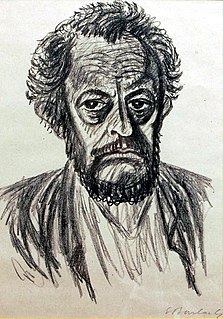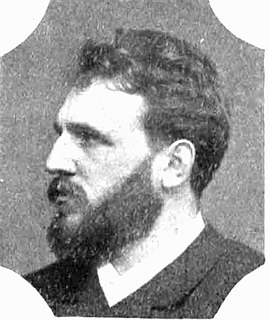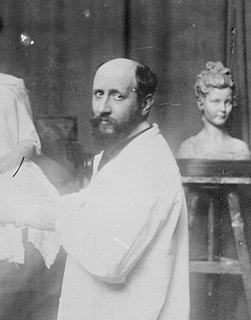
Otto Stichling (10 April 1866, Ohrdruf - 28 April 1912, Berlin) was a German sculptor in the Art Nouveau style.

Otto Stichling (10 April 1866, Ohrdruf - 28 April 1912, Berlin) was a German sculptor in the Art Nouveau style.

He was the illegitimate son of Auguste Wilhelmine Rosalie Stichling, the daughter of a shoemaker, who was still underage. His father has never been identified. In 1868, she married a tailor named Wilhelm Bernhard Frommann. By legal declaration, Otto retained the name Stichling. After completing his primary education, he served an apprenticeship as a porcelain painter at Kestner & Co.; known for their porcelain dolls. [1] During this time, his talents came to the attention of Duke Ernst II, who provided him with a scholarship to study in Berlin. From 1886 to 1893, he studied at the Academy of Arts with Fritz Schaper and Ernst Herter, while working as an assistant in several sculpture studios, to pay his living expenses. [2]
His first major project came in 1890, when he won a competition to design colossal figures for the Staatstheater Wiesbaden. He and Fritz Klimsch collaborated on a design for the "Kriegswissenschaft" (Science of War) figure. In 1900, he designed and modelled several bronze statues, wood panels, and majolica sculptures for Pallenberg Hall, at the Kunstgewerbemuseum in Cologne. From 1901 to 1902, he created window reliefs for a house owned by the toy manufacturer, Ernst Paul Lehmann . This was part of a renovation overseen by the architect, Bruno Möhring, with whom Stichling would collaborate on several other projects. [1] In 1904, he was awarded a gold medal at the Louisiana Purchase Exposition, for two groups of copper fountain figures, which were purchased by an anonymous American. [2]
After 1907, he was based in Hamburg. There, at the invitation of Hermann Muthesius. he worked as a teacher at the Altona arts and crafts school, and was one of the founders of the Altonaer Künstlerverein (artists' association). [1] He continued to work as a sculptor as well, creating sandstone statues of Martin Luther and Copernicus for the entrance at the new Oberrealschule . [3]

He returned to Berlin in 1910, to teach at the instructional annex of the Arts and Crafts Museum. [2] In 1911, he had a serious fainting spell while completing work on the interior of the ocean liner, SS Cap Finisterre , in Hamburg. This curtailed his teaching activities. A second severe attack left him unable to do any sculpting. He died, aged forty-six, of a heart attack, at a sanitarium in Berlin. [2]

Art Nouveau is an international style of art, architecture, and applied art, especially the decorative arts, known in different languages by different names: Jugendstil in German, Stile Liberty in Italian, Modernisme català in Catalan, etc. In English it is also known as the Modern Style. The style was most popular between 1890 and 1910 during the Belle Époque period that ended with the start of World War I in 1914. It was a reaction against the academic art, eclecticism and historicism of 19th century architecture and decoration. It was often inspired by natural forms such as the sinuous curves of plants and flowers. Other characteristics of Art Nouveau were a sense of dynamism and movement, often given by asymmetry or whiplash lines, and the use of modern materials, particularly iron, glass, ceramics and later concrete, to create unusual forms and larger open spaces.

Jugendstil was an artistic movement, particularly in the decorative arts, that was influential primarily in Germany and elsewhere in Europe to a lesser extent from about 1895 until about 1910. It was the German counterpart of Art Nouveau. The members of the movement were reacting against the historicism and neo-classicism of the official art and architecture academies. It took its name from the art journal Jugend, founded by the German artist Georg Hirth. It was especially active in the graphic arts and interior decoration.

Ernst Heinrich Barlach was a German expressionist sculptor, medallist, printmaker and writer. Although he was a supporter of the war in the years leading to World War I, his participation in the war made him change his position, and he is mostly known for his sculptures protesting against the war. This created many conflicts during the rise of the Nazi Party, when most of his works were confiscated as degenerate art. Stylistically, his literary and artistic work would fall between the categories of twentieth-century Realism and Expressionism.

Gerhard Marcks was a German artist, known primarily as a sculptor, but who is also known for his drawings, woodcuts, lithographs and ceramics.

The Vienna Secession is an art movement, closely related to Art Nouveau, that was formed in 1897 by a group of Austrian painters, graphic artists, sculptors and architects, including Josef Hoffman, Koloman Moser, Otto Wagner, and Gustav Klimt. They resigned from the Association of Austrian Artists in protest against its support for more traditional artistic styles. Their most influential architectural work was the Secession Building designed by Joseph Maria Olbrich as a venue for expositions of the group. Their official magazine was called Ver Sacrum, which published highly stylised and influential works of graphic art. In 1905 the group itself split, when some of the most prominent members, including Klimt, Wagner, and Hoffmann, resigned in a dispute over priorities, but it continued to function, and still functions today, from its headquarters in the Secession Building. In its current form, the Secession exhibition gallery is independently led and managed by artists.

Felix Georg Pfeifer was a German sculptor and medallist.

The Museum für Kunst und Gewerbe Hamburg is a museum of fine, applied and decorative arts in Hamburg, Germany. It is located centrally, near the Hauptbahnhof.

Will Lammert was a German sculptor. In 1959 he was posthumously awarded the National Prize of the German Democratic Republic.

Louis Sussmann-Hellborn, also spelled Ludwig Sussman Hellborn, was a German sculptor, painter, art collector and contractor.

Otto Lessing was a prominent German Historicist sculptor whose work largely shaped the appearance of Berlin in the late 19th and early 20th centuries. He was the son of history and landscape painter Carl Friedrich Lessing and the great great nephew of poet Gotthold Ephraim Lessing.

Karl Ludwig Otto Geyer was a German sculptor. His brother was the architect, Albert Geyer.

Georg Wrba was a German sculptor and graphic artist. He created some 3,000–4,000 works, including as a collaborator of the Zwinger workshop.

Adolf Brütt was a German sculptor. He was the founder of the Weimarer Bildhauerschule and its accompanying bronze foundry.

Peter Christian Breuer was a German sculptor.

August Friedrich Johann Kraus was a German sculptor.

Ernst Arnold Lyongrün (1871–1935) was a German practitioner of the Jugendstil or Art Nouveau style of decorative arts and a painter in the Impressionistic mode.

Otto Schmidt-Hofer (1873–1925) was a German sculptor who worked during the late 19th century and early 20th century. His work was primarily Neoclassical and Art Nouveau between 1893-1914 and Art Deco from 1915 until his death in 1925.
Ludwig Nick was a German sculptor and art professor, who worked in stone, bronze, wood and porcelain.

Ferdinand Theodor Martin Schauß was a German sculptor and medallist.

Rudolf Marcuse was a German sculptor of Jewish ancestry. Most of his works were relatively small, and many were designed for porcelain.
| Wikimedia Commons has media related to Otto Stichling . |